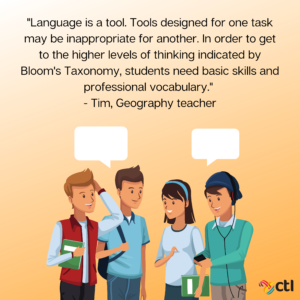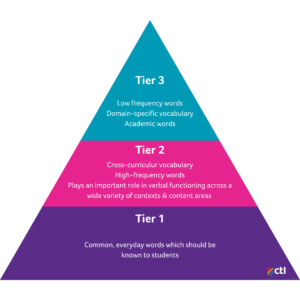 Vocabulary Development as we know it today is entirely different from what you likely encountered in school. Today we have a much more solid grasp on how students come to understand and fluently use new words. To maximize retention, students need multiple exposures to new content and opportunities to use the language authentically.
Vocabulary Development as we know it today is entirely different from what you likely encountered in school. Today we have a much more solid grasp on how students come to understand and fluently use new words. To maximize retention, students need multiple exposures to new content and opportunities to use the language authentically.
Vocabulary Development is the core of understanding critical content. Social studies teachers know well that, despite the views of many students, the discipline is not just about dates, names, and places. Social studies is built on historical and cultural context; relationships between people, places, and events; and the repeating patterns that explain these events throughout history and in the present day. These critical concepts form the basis for key vocabulary development in social studies. By focusing instruction on the core concepts of social studies, the repeating patterns, causes, effects, and relationships, teachers can better prepare students to learn the facts of social studies topics, and ensure that they are able to independently comprehend new content on their own.
It is an ongoing challenge for social studies teachers to address this exponentially increasing volume of information. Regardless of the level of the course or the ability of the learner, vocabulary provides the essential building blocks for the remaining content. Teachers understandably must be more selective about the topics they address in the classroom. Some content will not be covered. As we become more selective with the content we teach, we must also become selective with the skills upon which our curriculum is based.
College and Career Readiness Skills require students to be able to decode words in context. This is a skill that is essential to success in social studies as well as life. We need to prepare our students through vocabulary instruction to be able to understand and apply increasingly challenging texts. It is challenging to get students to reach the levels of application, synthesis, and evaluation essential to higher-order thinking if they do not have the essential vocabulary as the foundation. By focusing on key conceptual vocabulary in the social studies classroom, teachers can teach students not only course-specific vocabulary, but also language and skills that they will use in other disciplines and areas of life.
Taking more time at the onset or at an important juncture in the learning process can help students internalize and solidify new ideas, allowing for momentum when it really counts. This idea of slowing down to speed up is applied to literacy integration. By identifying key repeating concepts across the social studies and by intentionally integrating those same concepts again and again as new topics for instruction emerge, teachers will realize that the time taken to step aside from the forward motion of delivery of content will, in the end, not slow down instruction. Instead, it will increase the pace at which students are able to grasp content and improve their retention of information over the long run. Identifying key repeating concepts throughout social studies courses provides an opportunity for vertical articulation that will help students see the connections between all social studies courses.
What does vocabulary instruction and practice look like in your social studies classroom?
One of the difficulties of planning for vocabulary experiences is to know which high- frequency, multiple meaning vocabulary/concepts students will need direct instruction on (isolationism is an example) and to identify the appropriate vocabulary strategies to use when low-frequency, content-specific terms arise during a unit of study (deficit spending is an example). It’s easy to get lost in the minutiae of vocabulary laid out in state and national standards. In social studies, teachers and students are required regularly to grapple with dates, names, and places. It is difficult for both the teacher and the student to know what is the most important and what is key to deep understanding. Unlike the detailed content of National and State standards, the Common Core standards ask that social studies teachers focus on the skill of “determining the meaning of words and phrases as they are used in a text, including vocabulary describing political, social, or economic aspects of history/social science.” Approaching the teaching of vocabulary as a skill rather than as the teaching of specific words will ensure that you plan and implement vocabulary instruction in a manageable way that aids both your curriculum and student learning, rather feeling like you are adding one more thing to your curriculum.
As you review the content standards, ask yourself: Which ideas are so important that if students do not understand them, they will have difficulty comprehending the content? These terms make up the conceptual foundation for vocabulary study and are generally supplemented with a second tier of vocabulary that add dimension to the base.
Vocabulary can be broken into three tiers: Tier 1-Basic Vocabulary, Tier 2-High Frequency/Multiple Meaning Vocabulary, and Tier 3-Low-Frequency, Context-Specific Vocabulary.
| Quick Brainstorm
As you read, list some words from your subject area that fit in each Tier. |
|
| Tier 1 | |
| Tier 2 | |
| Tier 3 |
Tier 1 words are sight words that require no direct instruction and have simple meanings. These are words like law, people, and safety. These early reading words are introduced to children during preschool and primary years. 
Tier 2 words are those words students will encounter across a variety of domains, such as in other contents, conversations, and literature. These words require direct instruction because they increase a student’s reading comprehension, writing, and oral language skills. These include words like democracy, artifact, and civilization. Asking students to think critically with these types of words will facilitate long-term connections and meaning. Conversations and planning in cross-curricular teams can help identify words that students will use in multiple disciplines. For example, both a social studies teacher and an ELA teacher may find that the word “tolerance” is an applicable word for both classes; by discussing how the word is used in their classrooms and how it fits into the broader curriculum for each teacher, they may be able to have a common approach to both instruction and application of the word in a way that will allow students to gain greater understanding of the word.
Tier 3 words are words that are domain specific. These are words that a student would likely encounter in a specific content, sport, profession, association, etc. For instance, normative theory, détente, and polis are words students will encounter in the domain of a specific social studies course.
The national standards focus on two core sets of standards for instruction – thematic and disciplinary. Let’s look at one thematic standard to see how we dig to the core, as well as continuing concepts for key vocabulary development across topics.
Power, Authority, and Governance: Social studies teachers should possess the knowledge, capabilities, and dispositions to organize and provide instruction at the appropriate school level for the study of power, authority, and governance.
This thematic standard connects concepts across the social science disciplines and establishes a repeated pattern for understanding social science in the content of specific periods in time. If students have been well prepared for the study of social sciences at the middle and high school level, one might assume that the concepts of power, authority, and governance would be well understood and could simply be applied and discussed in the context of new learning. However, simply ensuring that students can generally describe power in the broad context of social studies is not sufficient. Within each content area, “power” has a unique meaning and level of importance. This is even more true across multiple social science disciplines. Take time below to create meaningful definitions for power in each of the specific disciplines noted.
| Social Science Disciplines | Define Power in Context |
| History | |
| Geography | |
| Economics | |
| Civics and Government | |
| Psychology |
The distinctions are clear, and each unique definition in context helps determine deep and rigorous understanding of power within distinct disciplines. By addressing these key concepts as foundational vocabulary to unlock understanding, social studies teachers provide better access to and understanding of the core content of the subject area.
The similarities of vocabulary in context are as important as the distinctions. When you dig into a single social studies discipline, the value of conceptual vocabulary becomes clear. Let’s work through an example. Use the chart below to note your understanding of power in the context of historical periods.
| Historical Period | Contextual Understanding of Power |
| World War II | |
| Early America | |
| Ancient Rome | |
| US Civil Rights Era | |
| What is the common theme or thread throughout the time periods? |
Your notes above should demonstrate that, while each period in history has its specific causes, events, impacts, and implications for the future, there are common threads within key social science concepts that continue over time. Understanding of those common threads increases students’ abilities to grasp new content quickly, apply what they have already learned, and make sense of the patterns and development of human society. In order for students to be able to apply these key concepts, conceptual vocabulary presented as the common themes of social studies must be integrated into ongoing study.
